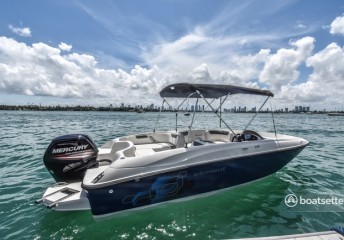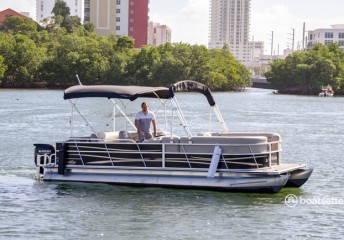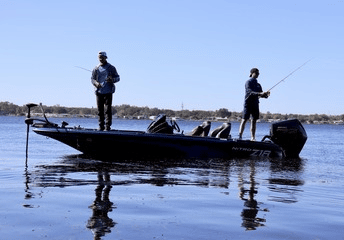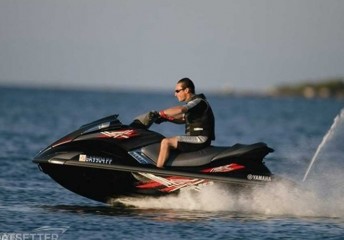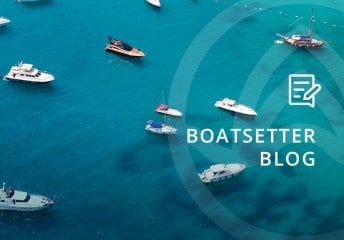Jet Ski Safety Guide, Plus Round Up of Top-Rated Courses
Last Updated on April 25, 2025 by Boatsetter Team
Jet skis are one of the most exciting ways to explore the water, but a little preparation goes a long way. Whether you’re driving or riding as a passenger, following basic safety practices helps ensure a fun, worry-free experience. From must-know rules to the best safety courses you can take, here’s everything you need to feel confident before you hit the throttle.
Find boat rentals & on-the-water experiences near you
Operating and jet ski legal requirements
Every trip is backed by the Boatsetter Promise. While U.S. federal law requires operators to be at least 16 years old without supervision, local regulations may vary. Owners and Captains will make sure you meet any legal requirements.
Whether you’re hitting the throttle yourself or riding as a passenger, Captains are experienced operators who will steer you in the right direction. Your trip should include a pre-ride briefing, covering how to start, stop, reboard, and troubleshoot. It’s also the perfect time to ask any questions and get comfortable before heading out.
Safety gear check: life jacket, helmet, lanyard
Life jackets are your best friend when riding a jet ski. You must wear a U.S. Coast Guard-approved life jacket or personal flotation device (PFD) at all times. It’s not just a smart safety move—it’s the law. Kill switches or safety lanyards must also be worn on the wrist throughout the ride, so if the driver falls off, the engine will immediately shut down and the PWC will stop.
Bring sunglasses to protect your eyes from UV rays and water spray. Don’t forget eco-friendly sunscreen to protect your skin too.
Know the basics before you ride
Before you hit the throttle, it’s important to understand a few key safety rules that will help you stay in control and avoid accidents on the water.
-
Stay aware of your surroundings. Pay attention to other boats, swimmers, obstacles, and changing weather conditions. Situational awareness helps you avoid collisions and make safer decisions.
-
Keep a safe distance. Give other boats—especially those towing skiers or tubers—plenty of space. Following too closely can be dangerous if someone falls into your path. Always check around and behind you before turning.
-
Don’t jump wakes. It might look fun to launch over the wake of another boat, but it’s risky. Wake jumping can easily lead to falls, injuries, or collisions.
-
Know what to do if you fall. If you’re thrown from your jet ski, the engine should automatically shut off. Swim back carefully—never try to hold on during a fall. When reboarding, the driver should climb on first, followed by any passengers.
Jet skis typically carry one to three people and have maximum weight limits for safe operation. Don’t exceed these limits, as it can affect how the PWC handles.
Keep to jet ski riding zones
Before you ride, make sure you know where it’s safe to operate your jet ski. Avoid heavy traffic areas like shipping lanes and channels, where large vessels and commercial boats are active. These crafts aren’t as quick or agile as a PWC, and it can be difficult for them to avoid a collision. Always give them plenty of space.
Honor jet ski speed limits
Pay attention to local speed limits, especially in harbors, marinas, and channels. Many areas are marked with “no wake” signs, requiring idle speeds typically under 5 knots. These rules apply to all vessels, including jet skis. Slowing down in designated areas protects swimmers, wildlife, and other boaters.
Protect the environment while you ride
Jet skis are a fun way to explore the water, but it’s important to ride responsibly and protect the environment along the way.
-
Avoid fuel and oil spills. Refuel carefully and never overfill the tank. Spilled fuel can harm marine life and water quality.
-
Respect no-wake zones. These areas protect fragile shorelines, wildlife habitats, and underwater vegetation from erosion and damage.
-
Steer clear of wildlife. Give animals like manatees, dolphins, and seabirds plenty of space. Disturbing wildlife can stress animals and disrupt their natural behaviors.
-
Leave no trace. Pack out all trash, including small items like food wrappers and plastic bottles. Secure loose gear to prevent it from blowing into the water.
5 Best jet ski safety courses
To wrap up your jet ski safety guide, here’s a curated list of top-rated, certified, and affordable jet ski safety courses:
1. Boat Ed
Interactive course with high-definition videos, animations, and quizzes. Available online; complete at your own pace on any device.
-
Certification: Approved by the U.S. Coast Guard (USCG) and the National Association of State Boating Law Administrators (NASBLA).
-
Student rating: 4.8 out of 5, based on over 230,000 reviews.
-
Cost: roughly $39.95.
2. iLearnToBoat
Gamified, scenario-based learning experience. Online course with interactive challenges; suitable for beginners.
-
Certification: Recognized by USCG and NASBLA.
-
Student rating: 4.7 out of 5, from over 33,000 reviews.
-
Cost: Approximately $54.95.
3. BoatUS Foundation (Florida only)
Only free online boating safety course approved in Florida. Online course; complete at your own pace.
-
Certification: Approved by the Florida Fish and Wildlife Conservation Commission and recognized by USCG.
-
Student rating: Highly rated for convenience and quality.
-
Cost: Free.
4. U.S. Coast Guard Auxiliary
Offers both virtual and in-person classes, including a Personal Watercraft (PWC) course. Find courses near you using their Public Education Course Finder.
-
Certification: Courses developed and taught by USCG Auxiliary instructors.
-
Student rating: Highly regarded for comprehensive instruction.
-
Cost: Varies by course and location.
5. America’s Boating Course (United States Power Squadrons)
Comprehensive course available online, via home study, or in a classroom. Course materials available in English and Spanish.
-
Certification: Approved by NASBLA and recognized by USCG.
-
Student rating: Well-reviewed for in-depth content and flexibility.
-
Cost: Approximately $34.95.

Zuzana Prochazka is an award-winning freelance journalist and photographer with regular contributions to more than a dozen sailing and powerboating magazines and online publications including Southern Boating, SEA, Latitudes & Attitudes and SAIL. She is SAIL magazines Charter Editor and the Executive Director of Boating Writers International. Zuzana serves as judge for SAIL’s Best Boats awards and for Europe’s Best of Boats in Berlin.
A USCG 100 Ton Master, Zuzana founded and manages a flotilla charter organization called Zescapes that takes guests adventure sailing at destinations worldwide.
Zuzana has lived in Europe, Africa and the United States and has traveled extensively in South America, the islands of the South Pacific and Mexico.

